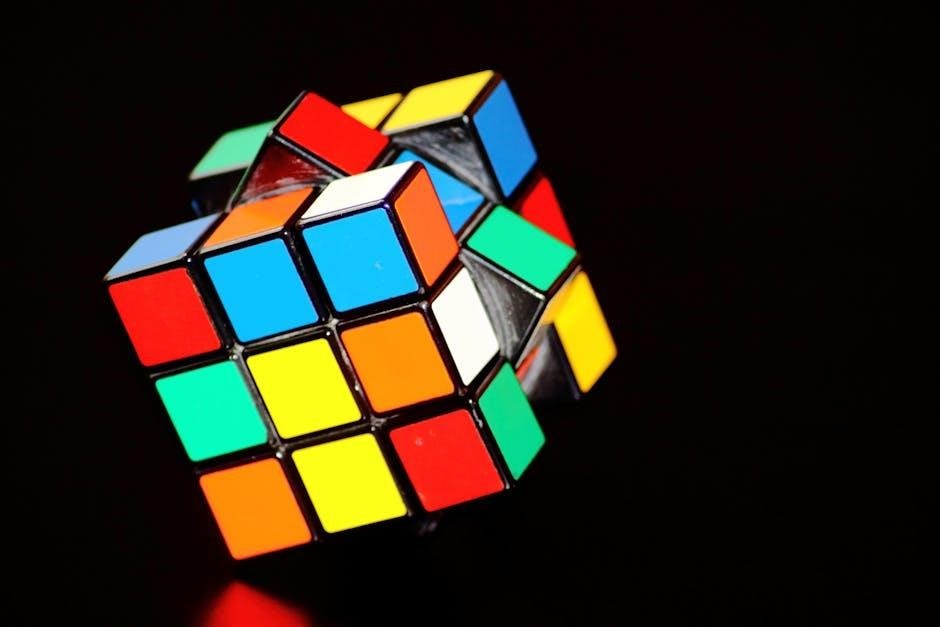
rubik 4×4 solution pdf
The 4×4 Rubik’s Cube, often called the Rubik’s Revenge, presents a fascinating challenge. It requires a different approach than the 3×3. Many people use the “reduction method,” which is what we will be learning to do in this guide. This involves reducing the 4×4 to an equivalent 3×3 state.
Brief Overview of the 4×4 Cube
The 4×4 Rubik’s Cube distinguishes itself from its 3×3 counterpart primarily through its lack of fixed center pieces. On a standard 3×3, the center pieces are fixed in relation to each other, indicating the color of each face once solved. However, on the 4×4, these center pieces can move freely, adding a new layer of complexity to the solving process.
The 4×4 comprises 24 center pieces (four on each face), 24 edge pieces, and 8 corner pieces. The objective is to manipulate these pieces until each face displays a solid color. The reduction method, a popular approach, involves treating the 4×4 as if it were a 3×3 after the center and edge pieces are appropriately paired.
Solving the 4×4 requires learning new algorithms and understanding unique concepts, such as parity errors. These parity errors don’t exist on the 3×3 and arise from the increased freedom of movement on the 4×4. Successfully navigating these challenges and mastering the 4×4 provides a rewarding and intellectually stimulating experience for puzzle enthusiasts.

Understanding the Reduction Method
The reduction method is a popular technique for solving the 4×4 Rubik’s Cube. It involves transforming the 4×4 into a state that mimics a 3×3. This is achieved by first solving the centers and then pairing the edges.
Concept of Reducing to a 3×3
The core idea behind solving the 4×4 Rubik’s Cube using the reduction method revolves around the concept of transforming it into a state that is solvable as if it were a standard 3×3 cube. This involves several key steps, primarily focusing on manipulating the centers and edges of the 4×4 to mimic the structure of a 3×3.
First, the center pieces, which are fixed in position on a 3×3, must be grouped together on the 4×4 to form solid-colored centers. This is crucial because it establishes a fixed reference point, similar to the 3×3. Next, the edge pieces, which are single pieces on a 3×3, need to be paired up on the 4×4. This is because the 4×4 has “inner” edges that need to be combined to form a single, wider edge, resembling the edges of a 3×3.
Once the centers are solved and the edges are paired, the 4×4 can be solved using 3×3 algorithms. However, it’s important to note that parity errors may arise, which are unique to the 4×4. These errors occur when the cube is in a state that is impossible to reach on a standard 3×3 and require specific algorithms to correct.

Step-by-Step Solution Guide
This guide will walk you through solving the 4×4 Rubik’s Cube. We’ll cover solving the centers, pairing the edges, and then solving it like a 3×3. Finally, we will address parity errors and their solutions.
Solving the Centers
The first crucial step in solving the 4×4 Rubik’s Cube using the reduction method is to solve the centers. Unlike the 3×3, the center pieces on the 4×4 are not fixed, requiring us to build them. Each center consists of four pieces of the same color that must be grouped together. This process is intuitive but requires practice.
Start by choosing a color to work with, typically white. Locate two white center pieces. Manipulate the outer layers until these two pieces are aligned and can be joined into a “bar” using inner layer moves. Create another white bar on a different face of the cube. Once you have two bars, bring them together to form the complete white center. Repeat this process for the opposite color, yellow.
Next, focus on the remaining four centers. It’s often easiest to solve adjacent centers first. Pay close attention to the color scheme of a Rubik’s Cube (white opposite yellow, red opposite orange, blue opposite green) to guide your placement. Continue creating bars and joining them until all six centers are solved. Accuracy in this step is key, as any mistakes here will complicate later stages of the solution.
Creating Center Bars
Creating center bars is the foundational step in solving the centers of a 4×4 Rubik’s Cube. This involves bringing together two center pieces of the same color to form a single, unified bar. This bar then serves as a building block for completing the entire center.
Begin by inspecting the cube and identifying two center pieces of the same color. These pieces may be located on different faces or even separated on the same face. Your goal is to maneuver these pieces so they are adjacent to each other on the same face. Use outer layer rotations (U, D, L, R, F, B) to bring the pieces closer. Once they are on the same face, you might need to use inner layer moves (Uw, Dw, Lw, Rw, Fw, Bw) to align them properly.
The key is to think ahead and anticipate how your moves will affect other parts of the cube. Sometimes, you may need to temporarily misalign other pieces to bring your target pieces together. However, always ensure you can easily restore the cube to its previous state. Practice this step with different color combinations to develop your intuition and efficiency. Remember, creating solid center bars is essential for a smooth and successful solve.
Joining Center Bars
After successfully creating individual center bars, the next crucial step is joining these bars to form complete centers on each face of the 4×4 Rubik’s Cube. This process requires careful planning and execution to avoid disrupting the already solved bars.
Start by identifying two center bars of the same color that need to be joined. Position these bars on opposite sides of the cube, typically on the left and right faces. This positioning allows for a controlled merging of the bars without disturbing other solved sections. Execute specific sequences of moves, often involving inner layer rotations (Rw, Lw) and outer layer rotations (U, D, F, B), to bring the bars together. The exact sequence will depend on the orientation of the bars relative to each other.
It’s essential to visualize the effect of each move before executing it. Incorrect moves can misalign existing bars or introduce unwanted changes to other parts of the cube. If you encounter difficulties, carefully backtrack and re-evaluate your approach. With practice, you’ll develop an intuitive understanding of how to manipulate the inner and outer layers to join the center bars efficiently and accurately, ultimately leading to the completion of the cube’s centers.
Pairing the Edges
Once the centers are solved, the next vital stage in solving the 4×4 Rubik’s Cube involves pairing the edges. Each edge piece on a 4×4 cube is effectively split into two identical pieces. The goal is to combine these pieces into single, wider edges that mimic the edges of a 3×3 cube. This step is necessary to reduce the 4×4 to a state where 3×3 solving techniques can be applied.
To begin, identify two matching edge pieces that need to be paired. These pieces will have the same two colors on their visible faces. Position these pieces strategically on the cube, typically on the top and bottom layers, to facilitate the pairing process.
A specific algorithm, often involving inner layer moves (like Rw and Lw), is then applied to bring the matching edge pieces together without disturbing the solved centers. This algorithm usually involves moving one edge piece to an adjacent face, connecting it with its matching piece, and then returning both pieces to their original layer as a paired edge. Repeat this process for all the remaining edges, ensuring each pair is correctly oriented. Successfully pairing all the edges is a key milestone in solving the 4×4 Rubik’s Cube.
Solving as a 3×3 Cube
After successfully pairing all the edges, the 4×4 Rubik’s Cube is effectively reduced to a state that resembles a standard 3×3 cube. At this point, you can apply your existing knowledge of 3×3 solving methods to complete the solve. This involves treating the paired edges and the solved center blocks as single pieces, just like in a 3×3.
Begin by orienting and permuting the edges and corners using standard 3×3 algorithms. Methods like CFOP (Fridrich), Roux, or beginner’s methods can all be applied. Focus on solving one layer at a time, starting with the first layer, then the second, and finally the last layer. Pay close attention to the orientation of the pieces, ensuring they are correctly positioned and aligned.
However, be aware that even in this “3×3” state, parity errors can still occur on the 4×4. These errors arise from the internal mechanisms of the 4×4 and require specific algorithms to correct. If you encounter a situation that seems impossible to solve using standard 3×3 techniques, it is likely a parity error. Be ready to identify and address these parity cases to fully solve the 4×4 cube. Otherwise the solve will be just like that of a 3×3.

Parity Errors and Solutions
Parity errors are unique to even-layered cubes like the 4×4; They manifest as unsolvable scenarios when treating the cube as a 3×3. Recognizing and correcting these errors is crucial for a complete 4×4 solve. Special algorithms exist to resolve these situations, restoring solvability.
Identifying Parity Cases
Parity errors on the 4×4 Rubik’s Cube can be tricky to spot, especially if you’re accustomed to solving the 3×3. These errors occur because the 4×4 has a different internal structure, leading to situations that are impossible on the 3×3.
One common parity case involves an edge flip, where two edges appear to be swapped even though they are in the correct location. This typically happens on the last layer after you’ve oriented all the other pieces. Another parity case involves swapping two single edges on the top layer. Again, this situation is impossible on a standard 3×3, indicating a parity error.
A key indicator of parity is when you reach a point in the 3×3 solving process where you know a move sequence should solve the cube, but instead, it leaves you with an impossible configuration. For instance, you might find that you need to swap two adjacent edges to complete the solve, which is a clear sign of parity.
By carefully observing the final stages of your solve and recognizing these impossible configurations, you can learn to identify parity cases on the 4×4 Rubik’s Cube.
Algorithms for Parity Correction
Once you’ve identified a parity error on your 4×4 Rubik’s Cube, you’ll need specific algorithms to correct it. These algorithms manipulate the inner layers of the cube to resolve the impossible configurations. It’s important to execute these algorithms precisely to avoid creating further issues.
For the common edge-flipping parity, a typical algorithm involves a sequence of wide moves on the middle layers. The goal is to swap the positions of specific center pieces, which effectively corrects the edge orientation issue. This algorithm often appears complex at first but becomes easier with practice.
Another common parity case, the edge swap, requires a different algorithm. This algorithm usually involves a combination of wide moves and standard 3×3 moves to swap the positions of two edges on the top layer. The algorithm must be applied carefully to prevent disrupting the solved portions of the cube.
When learning these algorithms, it’s helpful to practice them slowly and methodically, paying close attention to each move. With repetition, you’ll become more comfortable and efficient at executing them, allowing you to quickly resolve parity errors and complete your 4×4 solve.

Notation for 4×4 Algorithms
The 4×4 cube introduces new notations to represent moves on the inner layers. Standard 3×3 notation applies to the outer layers. Understanding these notations is crucial for executing 4×4 algorithms correctly. The key addition is the ‘w’ notation, representing “wide” moves.
Understanding Wide Moves (w)
On the 4×4 Rubik’s Cube, understanding wide moves, denoted by the letter “w” following a standard notation letter (like Fw, Bw, Lw, Rw, Uw, Dw), is crucial. These moves involve rotating two layers simultaneously, essentially turning both the outer layer and the adjacent inner layer in the same direction.
For example, Rw means rotating the right face and the layer next to it clockwise. Lw means rotating the left face and the adjacent layer clockwise. Uw means rotating the top two layers clockwise. Dw represents rotating the bottom two layers clockwise. Fw is rotating the front two layers clockwise, and Bw means rotating the back two layers clockwise.
The “w” notation allows us to manipulate the inner layers directly, which is necessary for solving the 4×4. Without wide moves, we would be limited to only turning the outer faces, making it impossible to solve the cube. Thinking of these as double-layer turns is key. Mastering wide moves is essential for efficient 4×4 solving.
Remember that the direction of the rotation (clockwise or counter-clockwise) is the same as in standard 3×3 notation. An apostrophe (‘) indicates a counter-clockwise rotation. So, Rw’ means rotating the right two layers counter-clockwise.